- There are no more items in your cart
- Shipping Calculated at checkout
- Sub-Total (inc. VAT) £0.00
Need Help?
Fireproof Paint for Wood
Fire retardant paints and intumescent coatings are vital to ensure the safety and fire resistance of timber and plasterboard surfaces. It’s also essential to meet British safety standard BS 476 when it comes to fire regulations for domestic and commercial buildings. Rawlins Paints stock one of the UK's widest selections of fire retardant paint for wood, timber and plasterboard, including coloured and clear coatings to provide Class 0, Class 1, 30 minute and 60-minute protection from fire. Click here for more info.
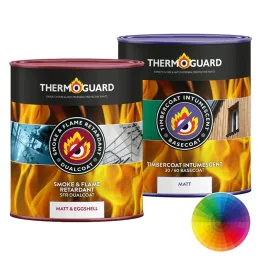
Thermoguard Timbercoat 60 Minute System
An intumescent paint system in 4,000+ colours for interior and exterior timber surfaces. Each pack contains the correct amount of basecoat (Timbercoat) and topcoat (Thermoguard Smoke & Flame Retardant (SFR) Dualcoat) to ensure protection is achieved inline with the manufacturers recommendations to the respective area in question....
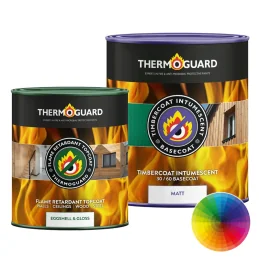
Thermoguard Timbercoat Door Upgrade System
An intumescent paint system to upgrade solid doors to 30min Fire Resistance, with 4,000+ colour options.Available as a convenient pack containing the required basecoat and topcoat to protect 2 doors in a white or coloured Eggshell or Gloss finish Thermoguard UK will issue a Fire Certificate for Authority approved projects following...
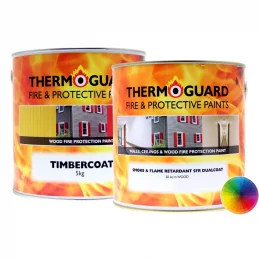
Thermoguard Timbercoat 30 Minute System
A 4,000+ colour intumescent paint system for interior and exterior timber surfaces. These packs have been created to help users ensure they are purchasing sufficient product for their project. Each pack contains the correct amount of basecoat (Timbercoat) and topcoat (Thermoguard Smoke & Flame Retardant (SFR) Dualcoat) to ensure...
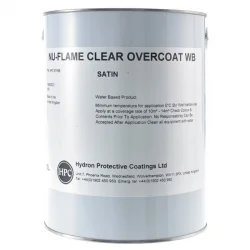
Hydron Nu-Flame Clear Overcoat
A clear varnish finish coating with flame retardant qualities. Protects the Nu-Flame Clear Impregnation when subjected to abrasion humidity, heat and general wear and tear.Tested to BS476 Part 7 Class 1 surface spread of flame and BS476 Part 6 Fire propagation. Designated Class '0' to current Building Regulations when used in conjunction...
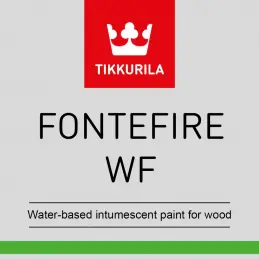
Tikkurila Fontefire WF
Water-borne intumescent coating with highest possible fire retardant properties on interior wood, fibreboard, chipboard and plywood surfaces in industrial painting processes.When subjected to heat, Fontefire WF expands and forms an insulating layer of foam. Has fire reaction class B-s1, d0, according to the standard EN 13501-...
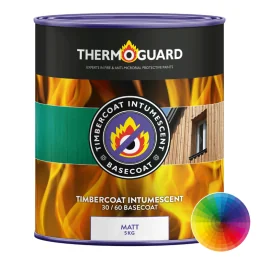
Thermoguard Timbercoat
An intumescent basecoat used as part 1 of a system to achieve 30 or 60 minute fire resistance for compartmentation.Can achieve 30 or 60 minutes Fire Resistance in certain instances subject to a specification from the Technical Department. For BS Class 1/0 and EN Class B only see Thermoguard Timbercoat Insulating Basecoat. Interior and...
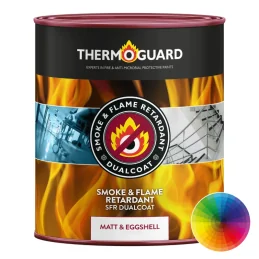
Thermoguard Smoke & Flame Retardant Dualcoat
4,000+ matt and eggshell colours for use over Thermoguard Timbercoat or Thermoguard Timbercoat Insulating Basecoat.Topcoat and maintenance paint for timber surfaces protected with Thermoguard Timbercoat. Emits a safe fire-damping vapour in a fire to control flame spread and suppress smoke. As part of a complete system achieves 30 or 60...
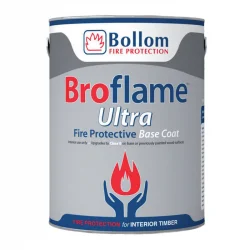
Bollom Broflame Ultra Basecoat
Decorative, thin film intumescent base coat that delivers a Class 0 rating over solid timber and particle boards when used in conjunction with Bollom Flameguard Ultra Topcoats.Achieves Class 0 fire protection rating to BS476: Parts 6 and 7 Hard wearing protective/decorative finish Water-based For all types of timber in communal areas
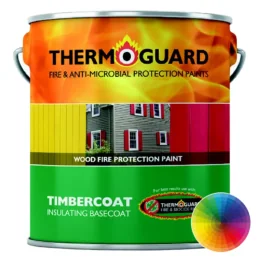
Thermoguard Timbercoat Insulating Basecoat
4,000+ colours, durable fire protection paint for interior and exterior timber surfaces:Meets new Fire Regulations standard:BS EN Class B s1 d0, BS Class 1. Class O Surface Spread of Flame.Can also achieve 30 & 60 minutes Fire Resistance in certain instances. Expands to create a barrier, insulating wood from heat and oxygen....
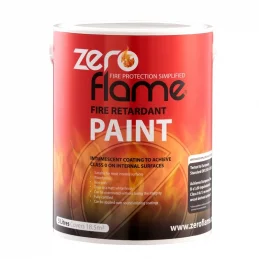
Zeroflame Fire Retardant Paint
A matt white, single-pack waterborne coating for wood that reduces ignitability for interior surfaces.Achieves Euroclass B s2 d0 (replaces UK Classes ‘0’ and ‘1’ BS 476 Part 6/7*). Can be overcoated with waterborne, non-flammable paints. Simple certificate application following purchase and application. Internal use. Can be applied by...
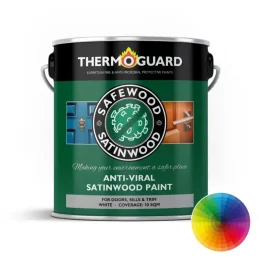
Thermoguard Safewood Satinwood Anti-Viral Paint
Decorative and protective paint finish in 4,000 satin colours applied over Safewood systems and Thermoguard Fire Varnish Basecoat. For the clear varnish version please see Satinwood Anti-Viral Varnish. Unless protected with a treatment to kill enveloped coronaviruses, flu and bacteria, hand contact with doors, frames, window sills and other...
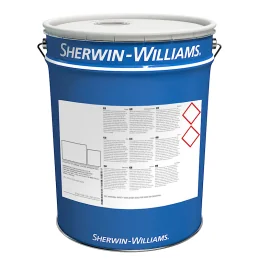
Sherwin-Williams Pyroplast Wood P
Single component, water-based fire protective coating system for use on most interior soft and hardwoods, including plywood, chipboard, fibre insulation board, hardboard and veneering. Can be overcoated with Pyroplast Top WB to colour.Formerly known as Sika Pyroplast Wood P For Professional Use Only Independently fire tested and approved...
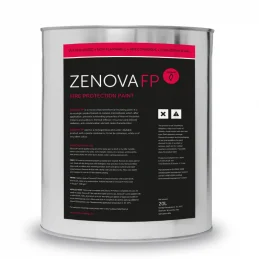
Zenova FP Intumescent Paint
Fire protective coating with 10 Years warranty when used with Zenova Primer. Suitable for both interior and exterior, exterior applications should be finished with Zenova PS TopcoatDesigned for use on metal, wood and other substrates, subject to approval. Efficient, simple fire protection. Easy and fast application with a short drying...
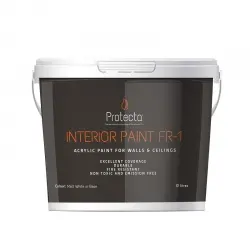
Protecta Interior Paint FR-1
Single-pack fire-rated acrylic paint providing fire resistance for walls and ceilings. Available in white and 27 colours. Suitable for application on wood, concrete, bricks, masonry, primed steel, gypsum, plastics, and most non-porous surfaces. Transforms combustible wood surfaces into fire-rated, CE-marked walls and ceilings without...
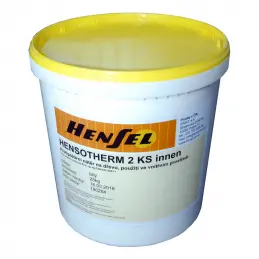
Hensel Hensotherm 2 KS White Interior
A single component, white intumescent coating for the fire protection of interior wooden structures. For use on solid wood, particle boards and plywood for construction with a thickness of under 8mm and a density of under 338 kg/m³.Fire behaviour is classified B-s1, d0 according to DIN EN 13501 (SBI-test) Classifies solid wood and wooden...
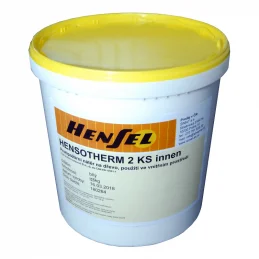
Hensel Hensotherm 2 KS Black Anthracite Interior
A single component, black anthracite intumescent coating for the fire protection of interior wooden structures. For use on solid wood, particle boards and plywood for construction with a thickness of under 12mm. It has been specially developed for the fire protection of wooden structures used in the theatre/stage/set design and saves the...
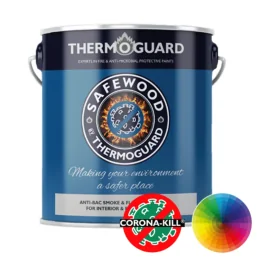
Thermoguard Safewood Insulating Basecoat
This product is due to be discontinued once existing stock has depleted; if the quantity you require is unavailable we can recommend Thermoguard Timbercoat Insulating Basecoat as a great alternative.Anti-viral fire protection paint in 2,000+ colours. Certified protection for Hallways, stairs and common areas in schools, hospitals, care...
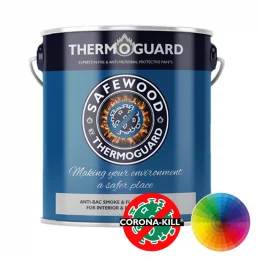
Thermoguard Safewood Anti-Viral Smoke & Flame Retardant Topcoat
This product is due to be discontinued once existing stock has depleted; if the quantity you require is unavailable please contact our technical team on 0113 2455450 (option 2) or email [email protected] where we will be happy to find an alternative product. For use over Thermoguard Safewood Insulating Basecoat - an anti-viral fire...
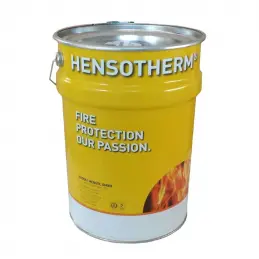
Hensel Hensotherm 2 KS Exterior
A single component, intumescent coating for the fire protection of exterior wooden structures. For use on wooden coreboards and solid wood with a thickness of under 12mm and a bulk density at least 630 kg/m³. Fire behaviour is classified C-s2, d0 according to DIN EN 13501-1 (SBI-test) if applied on all sides of the wooden material...
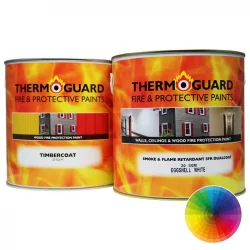
Thermoguard Timbercoat BS Class 1/0 & EN Class B System
4,000+ coloured fire retardant paint system for interior and exterior timber surfaces. Each pack contains the correct amount of basecoat (Thermoguard Timbercoat Insulating Basecoat) and topcoat (Smoke & Flame Retardant Dualcoat) to ensure protection is achieved in line with the manufacturers recommendations to the area in question....
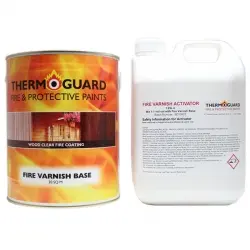
Thermoguard Fire Varnish Basecoat
A clear intumescent varnish that is the first coat of a 2 coat system (3 coats externally) for the decorative Fire Protection of timber and timber derived substrates to BS Class 1, Class 0 and EN Class B s2 d0. See Thermoguard Fire Varnish Overcoat (Interior) or Thermoguard Fire Varnish Overcoat (Exterior) to complete the system. Complete...
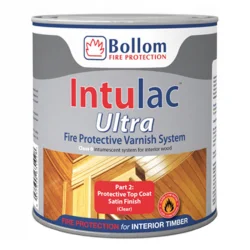
Bollom Intulac Ultra Topcoat
High performance decorative varnish system that delivers excellent clear fire protection to interior wood and timber.To be applied over Bollom Intulac Ultra Basecoat to complete a Class 0 fire-rated system Certificates of conformance & installation available Single pack
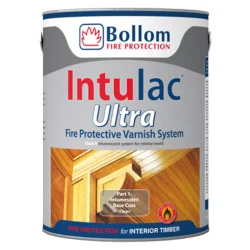
Bollom Intulac Ultra Basecoat
A clear, high-performance fire protection varnish coating for interior wood surfaces.Can be applied over existing varnish Simple 3 coat system to achieve Class 0 Single pack products Protects and highlights natural beauty of the wood Diminishes flue-gas density/temperature Insulates against heatMore Info View Similar Products...
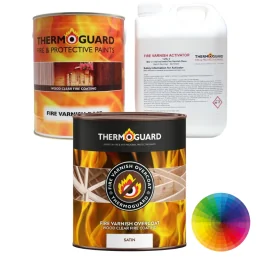
Thermoguard Fire Varnish BS Class 1/0 & EN Class B System
A clear fire retardant varnish for interior and exterior timber surfaces. Important!For use on timber with a minimum thickness of 9mm. Woodstains are only available on the following shipping options:Express: 1-3 Working Days Delivery (Thermoguard DS) Economy: 7-10 Working Days Nationwide DeliverySee further below for...
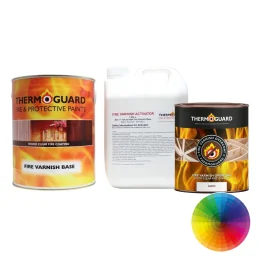
Thermoguard Fire Varnish 30 & 60 Minute System
A clear intumescent varnish (with 9 woodstain shades available) for interior and exterior timber surfaces. Each pack contains the correct amount of basecoat (Fire Varnish Basecoat) and topcoat (Thermoguard Fire Varnish Overcoat (Interior) or Thermoguard Fire Varnish Overcoat (Exterior)) to ensure protection is achieved inline with the...
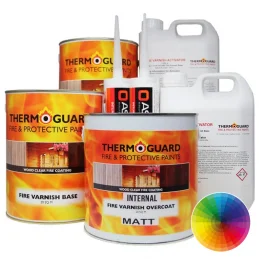
Thermoguard Fire Varnish Door Upgrade System
An intumescent varnish system to upgrade solid doors to 20 or 30min Fire Resistance:Available as a convenient pack containing the required basecoat, topcoat and mastic to protect 3 doors in a clear or woodstain coloured Matt or Satin finish Thermoguard UK will issue a Fire Certificate for Authority approved projects following completion...
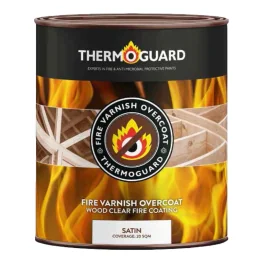
Thermoguard Fire Varnish Overcoat (Exterior)
A clear/wood stain-coloured decorative lacquer for use over Thermoguard Fire Varnish Basecoat for exterior surfaces.Each 20m2 pack of Thermoguard Fire Varnish Exterior Overcoat is sufficient to apply the required 2 coats to 20m2 of surface area.Important!Restricted to professional users. Not for sale to, or use by the general...
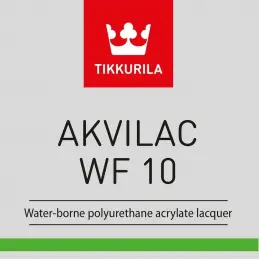
Tikkurila Akvilac WF 10
Single-pack water-borne lacquer used together with Fontefire WF Clear provides the B-s1, d0 classification.Chemical-resistant top lacquer for fire-retardant interior lacquer systems. Extends the usage area of fire-retardant lacquer by providing resistance to the most used household chemicals. Levels evenly and smoothly on top of...
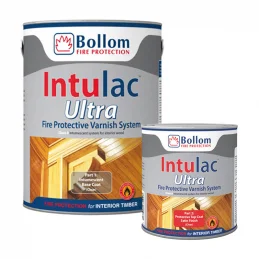
Bollom Intulac Ultra BS Class 0 Kit
Clear, fire-retardant varnish system that provides sufficient intumescent basecoat (Bollom Intulac Ultra Basecoat) and topcoat (Bollom Intulac Ultra Topcoat) to protect bare or previously varnished* interior timber surfaces** to BS Class 0. *Maximum of four, single, well-adhered coats. **Not suitable for surfaces exposed to mechanical stress...
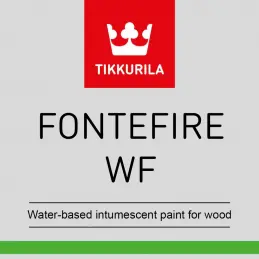
Tikkurila Fontefire WF Clear
A water-borne intumescent coating with highest possible fire retardant properties on interior and exterior wood. When subjected to heat, Fontefire WF Clear expands and forms an insulating layer of foam.Fontefire WF Clear has fire reaction class B-s1, d0, according to the standard EN 13501-1:2007+A1:2009, the highest possible for wood...
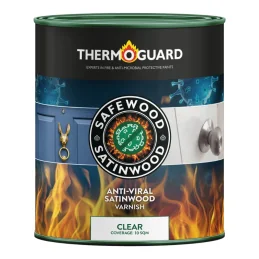
Thermoguard Safewood Satinwood Anti-Viral Varnish
A decorative and protective clear satin finish applied over Safewood systems and Thermoguard Fire Varnish Basecoat. For the Matt version see Mattwood Varnish. Unless protected with a treatment to kill enveloped coronaviruses, flu and bacteria, hand contact with doors, frames, window sills and other wood create a potential infection risk....
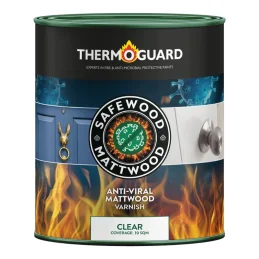
Thermoguard Safewood Mattwood Anti-Viral Varnish
A decorative and protective clear matt finish applied over Safewood systems and Thermoguard Fire Varnish Basecoat. For the Satin version see Satinwood Anti-Viral Varnish. Unless protected with a treatment to kill enveloped coronaviruses, flu and bacteria, hand contact with doors, frames, window sills and other wood create a potential...
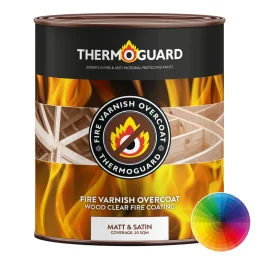
Thermoguard Fire Varnish Overcoat (Interior)
For use in combination with and over Thermoguard Fire Varnish Basecoat in internal applications - available in clear and a choice of woodstain colours.For timber/timber derived substrates Clear, UV and wear-resistant finish Certificate of Supply available when used over Thermoguard Fire Varnish BasecoatImportant!Woodstains are...
Need Help?
Need Help?
Fireproof paint for wood, also referred to as fire-retardant coatings or systems, is a crucial component in fire safety strategies for buildings, enhancing the fire performance of wood by reducing its ignitability and the spread of flames. The effectiveness of these coatings is highly dependent on the correct selection, application, and maintenance, as well as the specific type of wood being treated
Types of Fireproof Paint for Wood
Intumescent Coatings:
Mechanism: Intumescent coatings react to the heat generated during a fire by swelling and forming a thick, insulating char layer on the surface of the wood. This char layer acts as a barrier, reducing the transfer of heat to the wood, thereby slowing down ignition and the subsequent spread of flames.
Application: These coatings can be applied either off-site in a controlled environment or on-site directly to the wood surface. The application process usually involves ensuring the wood surface is clean, free from dirt, dust, grease, and any old coatings that might affect adhesion. Proper application in the correct thickness is crucial to ensure the coating performs effectively during a fire.
Ablative Coatings:
Mechanism: Ablative coatings work by releasing gases or vapours when exposed to high temperatures. These gases disrupt the chemical reactions within the flames, thereby reducing the heat release rate and flame spread.
Application: Similar to intumescent coatings, ablative coatings need to be applied under controlled conditions or in situ. They are generally applied using a brush, roller, or spray, depending on the manufacturer’s specifications.
Performance Considerations
Reaction to Fire: The primary function of fireproof paint for wood is to improve the material's reaction to fire, which includes reducing ignitability, flame spread, heat release, and overall combustibility. This is different from fire resistance, which refers to the ability of a material to withstand fire for a certain period without structural failure.
Impact of Wood Type: The natural fire performance of wood varies depending on the type, with hardwoods like oak generally performing better than softwoods like pine. Therefore, the effectiveness of the fireproof paint will also depend on the underlying wood substrate.
Testing and Certification: Fireproof paints must undergo rigorous testing to ensure they meet the required standards for fire performance. In the UK, these standards are detailed in documents like BS 476 Part 6 and Part 7, which cover fire propagation and surface spread of flame respectively. Compliance with these standards is essential for ensuring the coatings perform as expected in a fire scenario.
Practical Considerations for Application
Surface Preparation: For surface coatings, the wood must be properly prepared to ensure good adhesion of the fireproof paint. This may include cleaning, sanding, and priming the wood surface. Consult the manufacturer or product data sheets for further information on surface preparation.
Environmental Conditions: Application should be done under the right environmental conditions, considering factors like humidity and temperature, to avoid issues like poor adhesion or incomplete curing of the coating.
Maintenance and Reapplication: Depending on the type of coating and the conditions it is exposed to, reapplication may be necessary over time to maintain the fire retardant properties.
Limitations and Misconceptions
Compatibility: Care must be taken to ensure that the fireproof paint is compatible with any existing coatings or treatments on the wood surface. Overpainting without proper preparation can lead to reduced effectiveness.
Where is fireproof paint for wood used?
These applications highlight the importance of fireproof paint in enhancing the fire safety of wood and wood-based materials in various parts of a building.
1. Structural Timber
Fireproof paint is frequently applied to structural timber within buildings to enhance fire resistance. Timber, although a popular construction material, can be vulnerable in the event of a fire. When timber burns, it can contribute to the collapse of a structure if it loses its load-bearing capacity. Applying fireproof paint, particularly intumescent coatings, helps in forming a char layer that insulates the timber from heat, thus delaying the onset of structural failure. This treatment is crucial in maintaining the integrity of the building's structural frame during a fire.
2. Internal and External Woodwork
Fireproof paints are applied to both internal and external wood surfaces to improve their reaction to fire. This includes wood used in walls, ceilings, and decorative woodwork within the building's interior, as well as external wood features like cladding systems. The fireproof coatings help to reduce the ignitability, flame spread, and heat release of these materials, thereby improving their fire performance. The performance of the paint is dependent on the type of wood it is applied to, with hardwoods generally offering better fire performance than softwoods when coated.
3. Fire Doors
Fire doors are critical in preventing the spread of fire and smoke between compartments within a building. When a fire occurs, these doors must maintain their integrity, insulation, and resistance to flame spread. The paint enhances the door’s ability to withstand fire conditions by contributing to the overall fire-resistance rating. This includes maintaining the structural integrity of the door, preventing flame and smoke penetration, and ensuring the door frame and hardware also meet the required fire-resistance standards.
4. Escape Routes and Circulation Areas
In buildings, escape routes and circulation areas are crucial for safe evacuation during a fire. The surfaces in these areas, such as walls and ceilings, are often treated with fireproof paints to minimise the risk of fire spread. These treatments are particularly important in public buildings where the safety of large numbers of occupants is a priority. Fireproof paints in these areas help to ensure that the routes remain passable for longer periods during a fire, thereby aiding in evacuation efforts and preventing flashover.
5. Building Compartments
In building design, fireproof paint is applied to wood components within specific fire compartments. Compartmentation is a passive fire protection strategy that involves dividing a building into sections to contain a fire within a limited area. Fireproof paint on wooden elements in these compartments helps to control the spread of fire and smoke, ensuring that they do not pass through walls, ceilings, or floors into adjacent compartments. This is essential for maintaining the integrity of fire barriers and protecting the rest of the building during a fire.
Suitable Types of Wood for Fireproof Paint
Fireproof paint can be effectively used on a range of wood types, including hardwoods, softwoods, and wood-based derivatives like chipboard and MDF. However, its application on highly resinous or oily woods, previously coated surfaces, and certain sheet materials requires careful consideration. Proper surface preparation and adherence to manufacturer guidelines are essential to ensure the paint performs as intended and provides the necessary level of fire protection. In cases where the suitability of the wood or the existing surface treatment is uncertain, consulting with a fire protection specialist or conducting preliminary tests is recommended.
Hardwoods:
Examples: Birch, ash, oak.
Characteristics: Hardwoods generally have a denser structure and lower ignitability compared to softwoods. This natural resistance to fire makes them particularly suitable for fireproof paints. The effectiveness of the fireproof paint on hardwoods is typically higher, as the natural properties of these woods contribute positively to the overall fire resistance.
Application: When applying fireproof paint to hardwoods, it is essential to ensure the surface is clean and free of any contaminants that might affect adhesion.
Softwoods:
Examples: Cedar, pine, larch.
Characteristics: Softwoods are generally less fire-resistant than hardwoods due to their lower density and higher resin content. However, they can still be treated with fireproof paints. The performance of the paint on softwoods might not match that on hardwoods, but it still provides a significant improvement over untreated wood.
Considerations: Softwoods may require more thorough surface preparation, including sanding and cleaning, to ensure the paint adheres properly.
Wood-Based Derivatives:
Examples: Plywood, Medium Density Fibreboard (MDF).
Characteristics: These engineered wood products are commonly used in construction and furniture. Fireproof paints can be effectively applied to these materials, but the effectiveness depends on the specific characteristics of the product, such as density and the presence of any surface treatments.
Application: Careful consideration of the manufacturer's guidelines is crucial when applying fireproof coatings to these materials to ensure adequate protection.
Types of Wood or Conditions Requiring Caution or Unsuitability for Fireproof Paint
Highly Resinous or Oily Woods:
Examples: Some species of pine and other softwoods.
Concerns: Woods with high resin or oil content can be challenging when applying fireproof paints. These substances can prevent the paint from adhering properly, leading to reduced effectiveness. The presence of resin can also exacerbate the spread of fire, negating some of the benefits of the coating.
Mitigation: If using fireproof paint on such woods is necessary, thorough cleaning and possibly the use of a compatible primer are recommended to enhance adhesion.
Previously Coated Surfaces:
Concerns: If the wood has already been coated with a different finish, particularly one that is not compatible with fireproof paint, there may be issues with adhesion and overall effectiveness. Fireproof paints may not adhere well to surfaces coated with varnish, oil-based paints, or other film-forming coatings.
Mitigation: It is important to remove or properly prepare existing coatings before applying fireproof paint. Testing a small area first or consulting with the paint manufacturer is advisable.
Testing and Certification
Fireproof paint is critical for enhancing the fire safety of wood in buildings.
Thorough testing and certification are required to ensure the paint’s effectiveness.
The performance of fireproof paint depends on both the coating and the wood substrate.
Certification provides assurance of compliance with fire safety standards, with third-party certification offering the most comprehensive verification.
Proper application and maintenance are essential to ensure the long-term effectiveness of fireproof paint.
1. Introduction to Fireproof Paint and its Importance
Fireproof paint, also known as fire-retardant paint, is designed to protect wooden structures by delaying the spread of fire and reducing its intensity. This is particularly important for wood, which is naturally combustible. The paint either reacts chemically when exposed to heat, forming a protective layer (intumescent paint) or it acts as a flame retardant by releasing fire-suppressing chemicals (ablative coatings). These systems are crucial in enhancing the fire safety of buildings where wood is a key component.
2. Fire Testing Procedures
Before any fire-retardant paint can be certified and sold, it must undergo rigorous testing to ensure it meets the required fire safety standards. The testing process is designed to simulate real fire conditions as closely as possible, though there are inherent limitations in replicating every possible scenario.
Key Testing Methods:
Physical Fire Testing: The core of fire safety testing for coatings involves subjecting the treated wood to controlled fire conditions to measure its performance. This includes assessing the coating's ability to prevent ignition, reduce flame spread, and limit heat release.
BS 476 Part 6 (Fire Propagation Test): This test measures the extent to which a material contributes to the growth of a fire. It is particularly important for assessing the overall fire performance of wall and ceiling linings.
BS 476 Part 7 (Surface Spread of Flame Test): This test evaluates how flames spread across the surface of a material. The results classify materials into different classes based on their flame spread characteristics, with Class 1 being the best performance.
EN 13823 (Single Burning Item Test): This European standard evaluates the fire behaviour of materials in a controlled environment, specifically looking at how they contribute to the growth of a fire in a room scenario.
EN ISO 11925-2 (Ignitability Test): This test determines how easily a material ignites when exposed to a small flame, a crucial factor in assessing the fire risk posed by the material.
Considerations During Testing:
Substrate Interaction: The performance of fireproof paint is highly dependent on the type of wood it is applied to. Hardwoods generally offer better fire performance compared to softwoods, and the results of fire tests are valid only for the specific wood types and configurations tested.
System Performance: The effectiveness of the fire-retardant system is determined by both the coating and the substrate. For instance, the performance of a coating on a softwood surface will differ from its performance on hardwood, and this must be accounted for during testing.
3. Certification Process
After testing, fire-retardant paints must undergo a certification process to verify that they meet the necessary safety standards. Certification provides assurance to regulators, building owners, and contractors that the product is safe for use in buildings.
Types of Certification:
Third-Party Certification: This is the most robust form of certification. It involves an independent body, accredited by UKAS (United Kingdom Accreditation Service), assessing the product's performance based on test data. This process also includes factory audits, ongoing product verification, and ensuring that any changes in the product are reported and assessed.
Assessment and Expert Judgement: Where full certification is not pursued, manufacturers may obtain an assessment from accredited laboratories or qualified fire consultants. This assessment evaluates the product's performance across various tests and determines its suitability for specific applications. However, this does not include the ongoing quality control that third-party certification provides.
Fire Test Reports: These are detailed documents that record the results of the fire tests. They are critical for demonstrating compliance with fire safety standards but are limited to the specific configurations tested. Fire test reports are often complex and not directly usable for marketing purposes or for authorities like building control without additional certification.
Limitations of Testing and Certification:
Variability in Real-Life Scenarios: It is not practical to test every possible configuration of fire-retardant coatings and wood types. Manufacturers conduct a limited range of tests and use expert judgement to extend the applicability of these results. However, these assessments are inherently limited, and the actual performance in a real fire scenario may vary.
Interpretation of Test Results: Understanding and correctly interpreting fire test results and certifications is crucial. Misinterpretation can lead to the use of inappropriate products in situations where they may not perform as needed.
4. Regulatory Standards and Classifications
Fireproof paints in the UK are generally required to meet the Class 0 performance classification for wall and ceiling linings. This classification is achieved by passing both the BS 476 Part 6 and Part 7 tests.
UK and European Standards:
BS 476 Series: Historically, UK building regulations have relied on the BS 476 series of tests. These include assessments for fire propagation (Part 6) and surface spread of flame (Part 7), among others.
European Standards (EN Series): In addition to UK standards, European EN standards have been adopted, including tests like EN 13823 and EN ISO 11925-2. The European classification system ranges from A1 (non-combustible) to F (no performance determined), with specific tests required for each classification.
Comparison Between UK and EU Standards: Although there are no direct equivalences between UK classes and European ones, certain performances can be mapped approximately. For example, UK Class 0 is roughly equivalent to Euroclass B.
FAQs
Can fireproof paint be used on existing painted surfaces?
Yes, fireproof paint can be applied to existing painted surfaces, but careful preparation and adherence to guidelines are essential:
Surface Preparation:
Ensure the surface is clean, free of dirt, grease, and moisture.
Remove previous coatings that are incompatible with the new fireproof paint.
Manufacturer’s Guidelines:
Check compatibility with the existing surface.
Follow instructions for application, including temperature, humidity, and coating thickness.
Testing and Trials:
Perform a trial application to ensure proper adhesion and curing.
Verify the coated surface meets required fire performance standards.
Environmental Conditions:
Apply within specified temperature and humidity ranges.
Application Methods:
Use brush, roller, or spray, ensuring correct thickness through multiple coats in line with the manufacturer’s guidelines.
Proper preparation ensures the effectiveness of the fireproof paint on existing surfaces.
Does paint protect wood from fire?
Paint can protect wood from fire if it is a fire-retardant or intumescent paint. These paints are designed to improve the fire performance of wood by slowing down the spread of flames and reducing heat release.
Fire-retardant coatings form a protective layer that insulates the wood and prevents it from igniting easily, while intumescent coatings swell up when exposed to heat, forming a char layer that further insulates the wood and slows down combustion.
However, it is important to note that these treatments do not make wood completely fireproof and should be part of a comprehensive fire protection strategy.
How long does fireproof paint last?
The longevity of fireproof paint can vary depending on the type and application method. Generally, intumescent coatings, which swell when exposed to heat to form an insulating char layer, can provide fire resistance from 30 to 60 minutes.
The effectiveness and duration of fireproof paint also depend on factors such as environmental conditions, the substrate to which it is applied, and adherence to manufacturer guidelines during application. Proper maintenance and periodic inspections are essential to ensure that the fireproof coating remains effective throughout its expected lifespan.
Does fire retardant paint work?
Yes, fire retardant paint does work, but its effectiveness depends on the proper selection, specification, and application to the appropriate substrate. Fire retardant paints are part of passive fire protection systems and are designed to enhance the "reaction to fire" performance of materials, such as reducing ignitability, flame spread, and heat release. However, the performance of these paints is influenced by the characteristics of the substrate they are applied to. For instance, the same paint may perform differently on hardwood compared to softwood. Moreover, it is crucial to follow the manufacturer's guidelines and ensure the paint system is tested and certified under relevant standards for the intended use.
